Grey-Based Taguchi Multiobjective Optimization and Artificial Intelligence-Based Prediction of Dissimilar Gas Metal Arc Welding Process Performance
Abstract
1. Introduction
2. Research Methodology
2.1. Plan of Investigation
2.2. Workpiece Nomenclature
2.3. Weld Bead Geometry and Dilution Percentage
2.4. Developing Statistical Model Using Grey-Based Taguchi Method
2.5. Development of the Prediction Models
2.5.1. Regression Analysis
2.5.2. Weld Bead Geometry and Dilution Prediction—ANN Approach
2.5.3. Adaptive Neuro-Fuzzy Inference System (ANFIS)
3. Results and Discussion
3.1. Multiobjective Optimization—Statistical Model
Determining GRG Using S/N Ratio
3.2. Regression Analysis
3.3. ANN Prediction Model
3.4. The Adaptive Neuro-Fuzzy Inference System (ANFIS)
Comparison between the Prediction Models
3.5. Confirmatory Test
4. Conclusions
Author Contributions
Funding
Institutional Review Board Statement
Informed Consent Statement
Data Availability Statement
Acknowledgments
Conflicts of Interest
References
- Teng, T.-L.; Fung, C.-P.; Chang, P.-H.; Yang, W.-C. Analysis of residual stresses and distortions in T-joint fillet welds. Int. J. Press. Vessel. Pip. 2001, 78, 523–538. [Google Scholar] [CrossRef]
- Derakhshan, E.D.; Yazdian, N.; Craft, B.; Smith, S.; Kovacevic, R. Numerical simulation and experimental validation of residual stress and welding distortion induced by laser-based welding processes of thin structural steel plates in butt joint configuration. Opt. Laser Technol. 2018, 104, 170–182. [Google Scholar] [CrossRef]
- Fuentes, A.L.G.; Salas, R.; Centeno, L.; del Rosario, A.V. Crack growth study of dissimilar steels (Stainless–Structural) butt-welded unions under cyclic loads. Procedia Eng. 2011, 10, 1917–1923. [Google Scholar] [CrossRef][Green Version]
- Devaraj, J.; Ziout, A.; Abu Qudeiri, J.E. Dissimilar Non-Ferrous Metal Welding: An Insight on Experimental and Numerical Analysis. Metals 2021, 11, 1486. [Google Scholar] [CrossRef]
- Davis, J.R. (Ed.) Corrosion of Weldments; 1. print; ASM Internat: Materials Park, OH, USA, 2006; ISBN 978-0-87170-841-0. [Google Scholar]
- Shushan, S.M.; Charles, E.A.; Congleton, J. The environment assisted cracking of diffusion bonded stainless to carbon steel joints in an aqueous chloride solution. Corros. Sci. 1996, 38, 673–686. [Google Scholar] [CrossRef]
- Celik, A.; Alsaran, A. Mechanical and Structural Properties of Similar and Dissimilar Steel Joints. Mater. Charact. 1999, 43, 311–318. [Google Scholar] [CrossRef]
- Ghosh, N.; Pal, P.K.; Nandi, G. GMAW dissimilar welding of AISI 409 ferritic stainless steel to AISI 316L austenitic stainless steel by using AISI 308 filler wire. Eng. Sci. Technol. Int. J. 2017, 20, 1334–1341. [Google Scholar] [CrossRef]
- Ramarao, M.; King, M.F.L.; Sivakumar, A.; Manikandan, V.; Vijayakumar, M.; Subbiah, R. Optimizing GMAW parameters to achieve high impact strength of the dissimilar weld joints using Taguchi approach. Mater. Today Proc. 2021, in press. [Google Scholar] [CrossRef]
- Dong, Q.; Shen, L.; Cao, F.; Jia, Y.; Liao, K.; Wang, M. Effect of Thermomechanical Processing on the Microstructure and Properties of a Cu-Fe-P Alloy. J. Mater. Eng. Perform. 2015, 24, 1531–1539. [Google Scholar] [CrossRef]
- Rop, P. Drum Plus: A drum type HRSG with Benson benefits. Mod. Power Syst. 2010, 30, 35–40. [Google Scholar]
- Dzierwa, P. Optimum heating of pressure components of steam boilers with regard to thermal stresses. J. Therm. Stresses 2016, 39, 874–886. [Google Scholar] [CrossRef]
- ASME. Boiler and Pressure Vessel Code (BPVC) 2021 Complete Set; ASME: New York, NY, USA, 2021. [Google Scholar]
- Rodrigues, D.M.; Menezes, L.F.; Loureiro, A.; Fernandes, J.V. Numerical study of the plastic behaviour in tension of welds in high strength steels. Int. J. Plast. 2004, 20, 1–18. [Google Scholar] [CrossRef]
- Easterling, K. Introduction to the Physical Metallurgy of Welding; Elsevier Science: Kent, UK, 2014; ISBN 978-1-4831-4166-4. [Google Scholar]
- Mohanty, U.K.; Sharma, A.; Abe, Y.; Fujimoto, T.; Nakatani, M.; Kitagawa, A.; Tanaka, M.; Suga, T. Geometric Model of the Weld Bead in DC and Square AC Submerged Arc Welding of 2.25 Cr-1 Mo Heat Resistant Steel. In Advances in Additive Manufacturing and Joining; Shunmugam, M.S., Kanthababu, M., Eds.; Lecture Notes on Multidisciplinary Industrial Engineering; Springer: Singapore, 2020; pp. 433–445. ISBN 978-981-329-432-5. [Google Scholar]
- Zhao, L.; Shao, C.; Takashima, Y.; Minami, F.; Lu, F. Numerical Investigation on Fracture Initiation Properties of Interface Crack in Dissimilar Steel Welded Joints. Chin. J. Mech. Eng. 2020, 33, 27. [Google Scholar] [CrossRef]
- Esme, U.; Bayramoglu, M.; Kazancoglu, Y.; Ozgun, S. Optimization of Weld Bead Geometry in TIG Welding Process using Grey Relation Analysis And Taguchi Method. Mater. Tehnol. 2009, 43, 143–149. [Google Scholar]
- Jeyaganesh, D.; Ziout, A.; Qudeiri, J.A. Optimization of P-GMAW parameters using Grey relational analysis and Taguchi method. In Proceedings of the 2021 IEEE 12th International Conference on Mechanical and Intelligent Manufacturing Technologies (ICMIMT), Cape Town, South Africa, 13–15 May 2021; pp. 191–196. [Google Scholar]
- Tomków, J.; Sobota, K.; Krajewski, S. Influence of tack welds distribution and welding sequence on the angular distortion of TIG welded joint. FU Mech. Eng. 2020, 18, 611–621. [Google Scholar] [CrossRef]
- Vora, J.; Patel, V.K.; Srinivasan, S.; Chaudhari, R.; Pimenov, D.Y.; Giasin, K.; Sharma, S. Optimization of Activated Tungsten Inert Gas Welding Process Parameters Using Heat Transfer Search Algorithm: With Experimental Validation Using Case Studies. Metals 2021, 11, 981. [Google Scholar] [CrossRef]
- Mastanaiah, P.; Sharma, A.; Reddy, G.M. Process parameters-weld bead geometry interactions and their influence on mechanical properties: A case of dissimilar aluminium alloy electron beam welds. Def. Technol. 2018, 14, 137–150. [Google Scholar] [CrossRef]
- Nwobi-Okoye, C.C.; Ochieze, B.Q.; Okiy, S. Multi-objective optimization and modeling of age hardening process using ANN, ANFIS and genetic algorithm: Results from aluminum alloy A356/cow horn particulate composite. J. Mater. Res. Technol. 2019, 8, 3054–3075. [Google Scholar] [CrossRef]
- Yuan, Z.; Wang, L.-N.; Ji, X. Prediction of concrete compressive strength: Research on hybrid models genetic based algorithms and ANFIS. Adv. Eng. Softw. 2014, 67, 156–163. [Google Scholar] [CrossRef]
- Kochar, P.; Sharma, A.; Suga, T.; Tanaka, M. Prediction and Control of Asymmetric Bead Shape in Laser-Arc Hybrid Fillet-Lap Joints in Sheet Metal Welds. Lasers Manuf. Mater. Process. 2019, 6, 67–84. [Google Scholar] [CrossRef]
- Tuominen, V. The measurement-aided welding cell—Giving sight to the blind. Int. J. Adv. Manuf. Technol. 2016, 86, 371–386. [Google Scholar] [CrossRef]
- Xiong, J.; Zhang, G.; Hu, J.; Wu, L. Bead geometry prediction for robotic GMAW-based rapid manufacturing through a neural network and a second-order regression analysis. J. Intell. Manuf. 2014, 25, 157–163. [Google Scholar] [CrossRef]
- Sreeraj, P.; Kannan, T.; Maji, S. Optimization of GMAW Process Parameters Using Particle Swarm Optimization. Int. Sch. Res. Not. Metall. 2013, 2013, 460651. [Google Scholar] [CrossRef][Green Version]
- Sreeraj, P.; Kannan, T.; Maji, S. Estimation of Optimum Dilution in the GMAW Process Using Integrated ANN-GA. J. Eng. 2013, 2013, 285030. [Google Scholar] [CrossRef][Green Version]
- Almeida, H.A.L.D.; Teixeira, F.R.; Mota, C.A.M.D.; Scotti, A. The Effect of Switchback Parameters on Root Pass Formation of Butt Welds with Variable Gap. J. Manuf. Mater. Process. 2019, 3, 54. [Google Scholar] [CrossRef]
- Karadeniz, E.; Ozsarac, U.; Yildiz, C. The effect of process parameters on penetration in gas metal arc welding processes. Mater. Des. 2007, 28, 649–656. [Google Scholar] [CrossRef]
- Casarini, A.; Coelho, J.P.; Olívio, É.; Braz-César, M.T.; Ribeiro, J. Optimization and Influence of GMAW Parameters for Weld Geometrical and Mechanical Properties Using the Taguchi Method and Variance Analysis. ICEUBI2019 Int. Congr. Eng. Eng. Evol. 2020, 5, 781–794. [Google Scholar] [CrossRef]
- Kuo, C.-F.J.; Su, T.-L. Optimization of multiple quality characteristics for polyether ether ketone injection molding process. Fibers Polym. 2006, 7, 404–413. [Google Scholar] [CrossRef]
- Kuo, Y.; Yang, T.; Huang, G.-W. The use of a grey-based Taguchi method for optimizing multi-response simulation problems. Eng. Optim. 2008, 40, 517–528. [Google Scholar] [CrossRef]
- Liu, H.-T.; Cheng, H.S. An Improved Grey Quality Function Deployment Approach Using the Grey TRIZ Technique. Comput. Ind. Eng. 2016, 92, 57–71. [Google Scholar] [CrossRef]
- Sharma, A.; Verma, D.K.; Arora, N. A scheme of comprehensive assessment of weld bead geometry. Int. J. Adv. Manuf. Technol. 2016, 82, 1507–1515. [Google Scholar] [CrossRef]
- Choudhury, S.; Sharma, A.; Mohanty, U.K.; Kasai, R.; Komura, M.; Tanaka, M.; Suga, T. Mathematical model of complex weld penetration profile: A case of square AC waveform arc welding. J. Manuf. Process. 2017, 30, 483–491. [Google Scholar] [CrossRef]
- Chaki, S. Neural networks based prediction modelling of hybrid laser beam welding process parameters with sensitivity analysis. SN Appl. Sci. 2019, 1, 1285. [Google Scholar] [CrossRef]
- Choudhury, B.; Chandrasekaran, M.; Devarasiddappa, D. Development of ANN modelling for estimation of weld strength and integrated optimization for GTAW of Inconel 825 sheets used in aero engine components. J. Braz. Soc. Mech. Sci. Eng. 2020, 42, 308. [Google Scholar] [CrossRef]
- Hosoz, M.; Ertunc, H.M.; Bulgurcu, H. An adaptive neuro-fuzzy inference system model for predicting the performance of a refrigeration system with a cooling tower. Expert Syst. Appl. 2011, 38, 14148–14155. [Google Scholar] [CrossRef]
- Kim, J.; Kim, J.; Pyo, C.; Chun, K. Bead Geometry Prediction Model for 9% Nickel Laser Weldment, Part 1: Global Regression Model vs. Modified Regression Model. Processes 2021, 9, 793. [Google Scholar] [CrossRef]
- Gunaraj, V.; Murugan, N. Application of response surface methodology for predicting weld bead quality in submerged arc welding of pipes. J. Mater. Process. Technol. 1999, 88, 266–275. [Google Scholar] [CrossRef]
- Yang, L.J.; Bibby, M.J.; Chandel, R.S. Linear regression equations for modeling the submerged-arc welding process. J. Mater. Process. Technol. 1993, 39, 33–42. [Google Scholar] [CrossRef]
- Vedrtnam, A.; Singh, G.; Kumar, A. Optimizing submerged arc welding using response surface methodology, regression analysis, and genetic algorithm. Def. Technol. 2018, 14, 204–212. [Google Scholar] [CrossRef]
- Atuanya, C.U.; Government, M.R.; Nwobi-Okoye, C.C.; Onukwuli, O.D. Predicting the mechanical properties of date palm wood fibre-recycled low density polyethylene composite using artificial neural network. Int. J. Mech. Mater. Eng. 2014, 9, 7. [Google Scholar] [CrossRef]
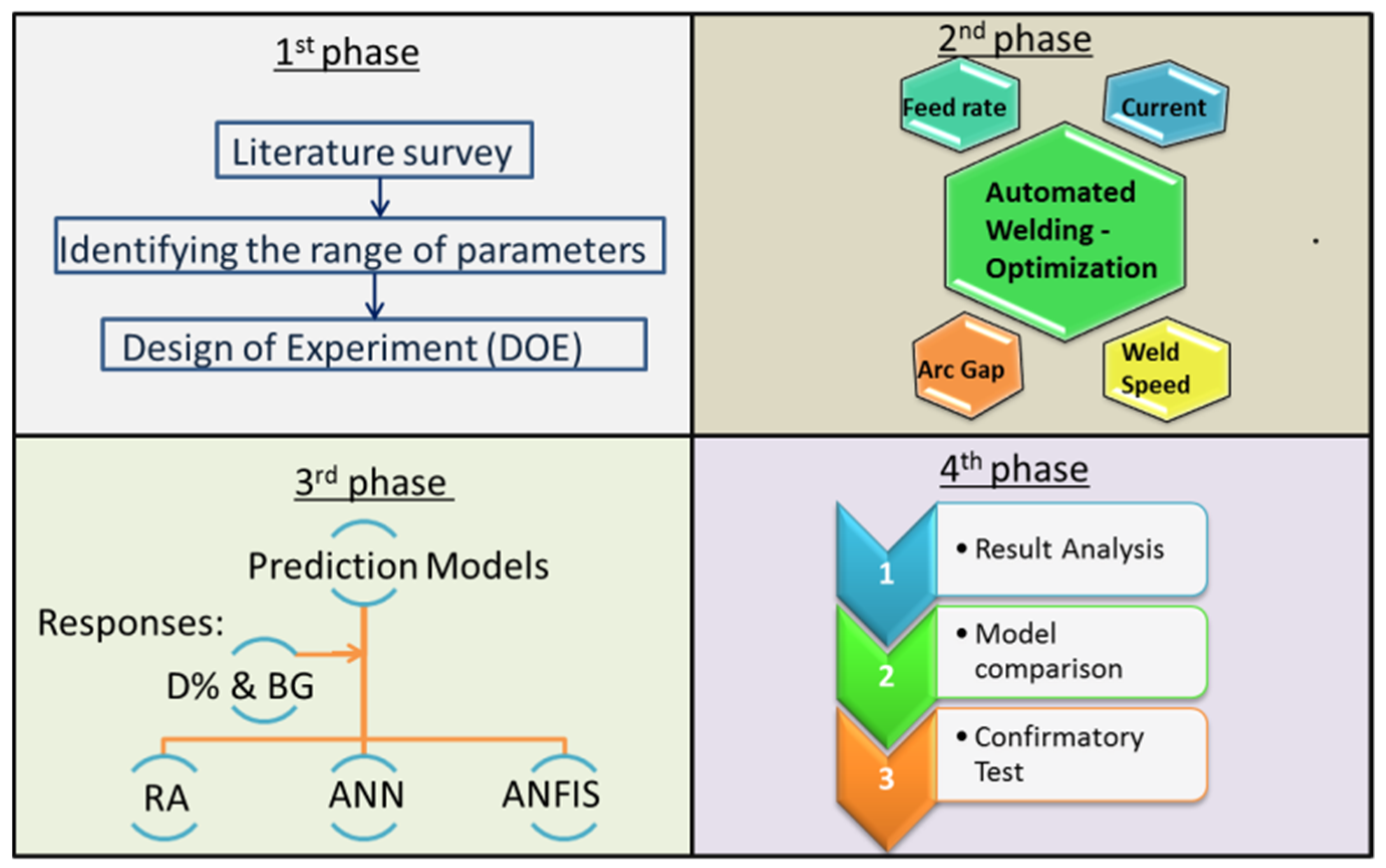
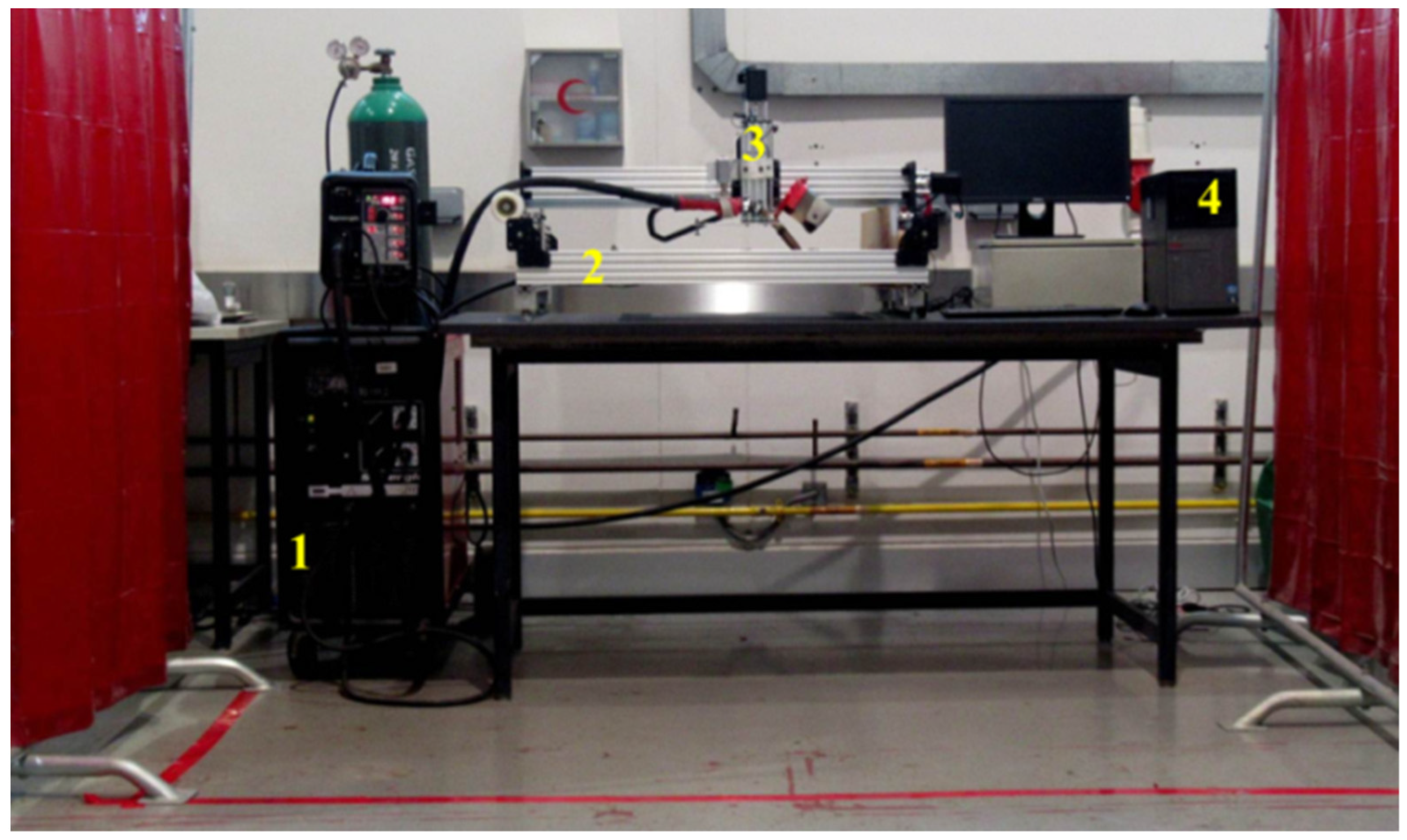
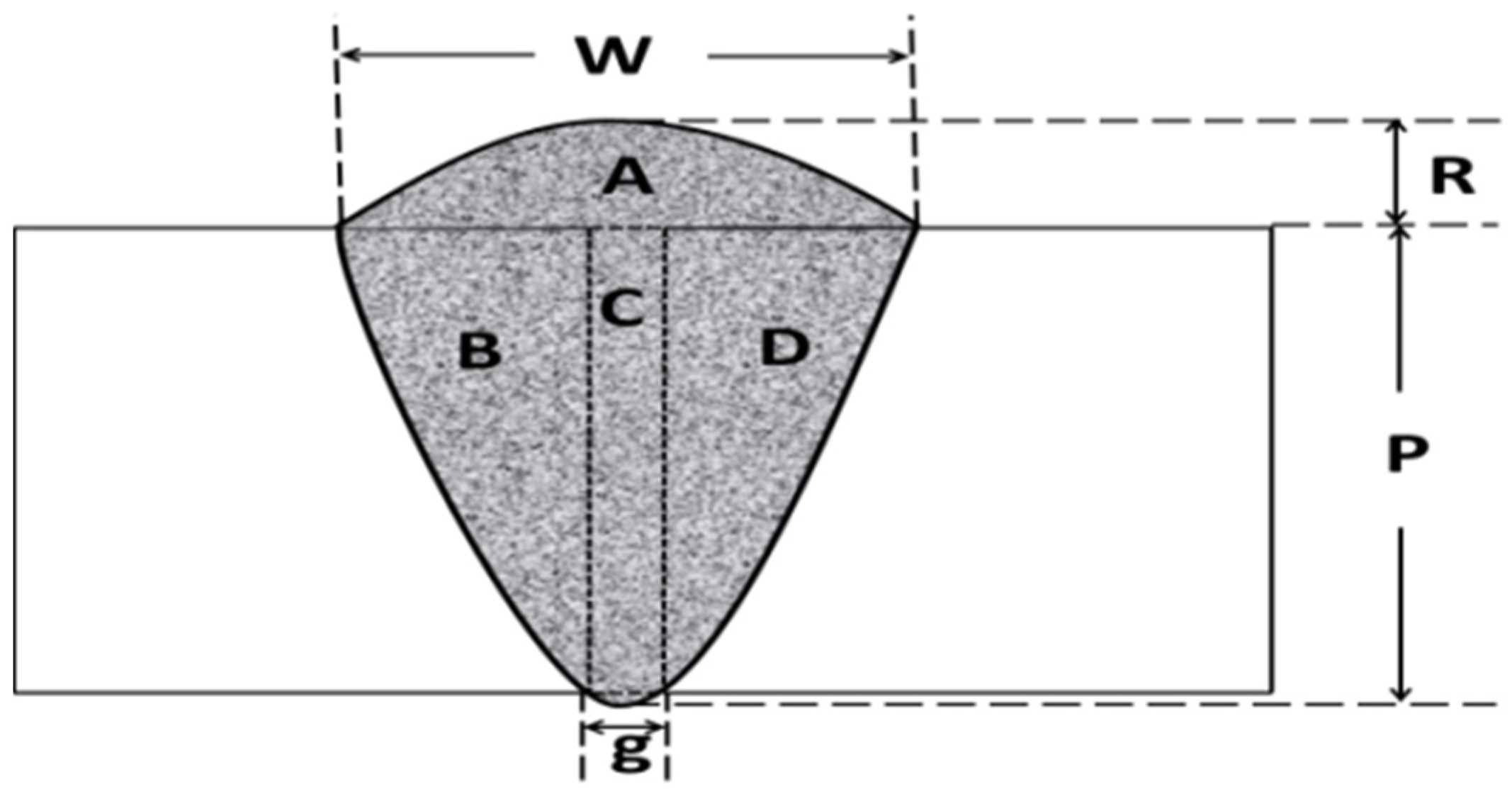
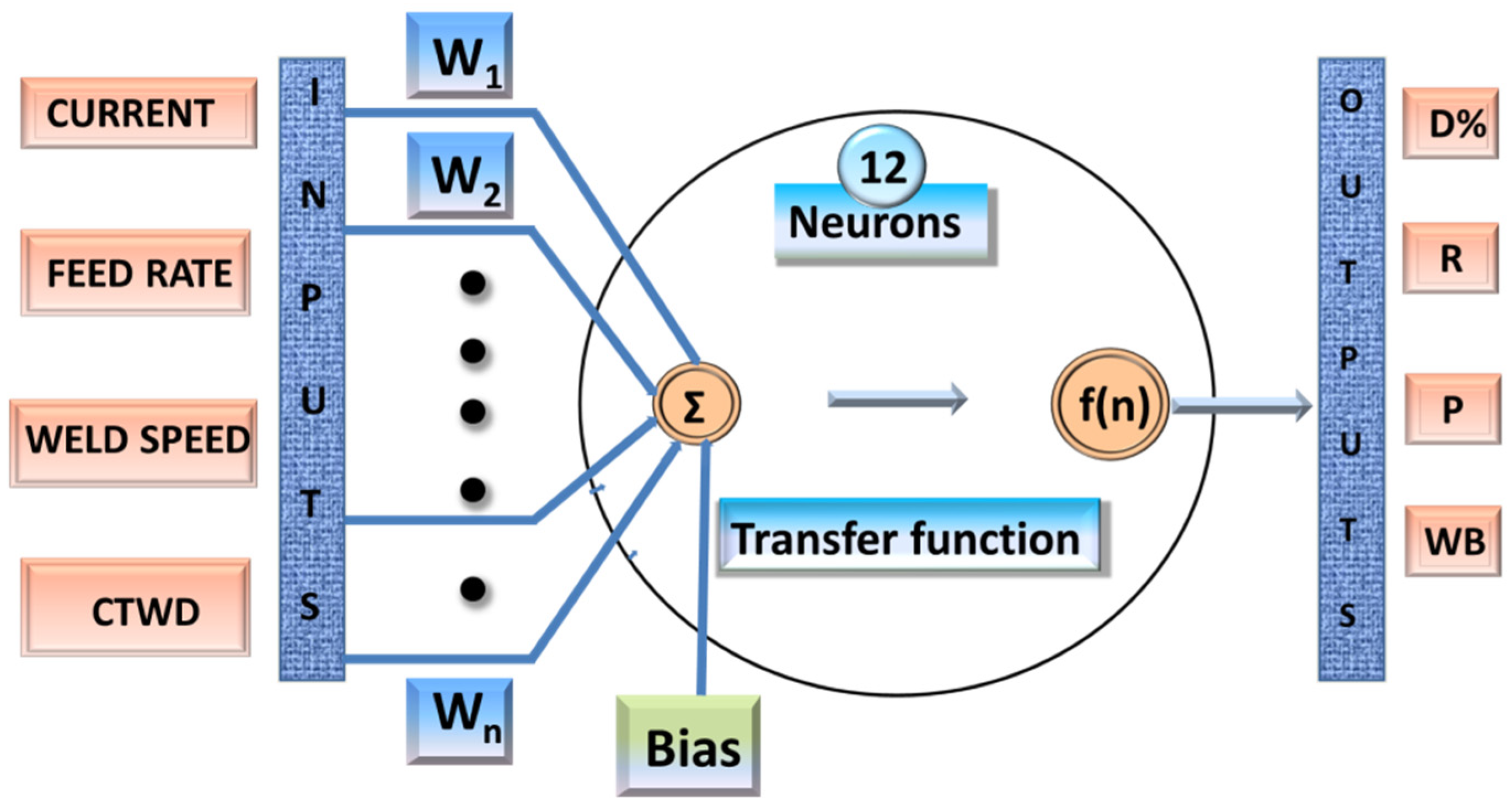

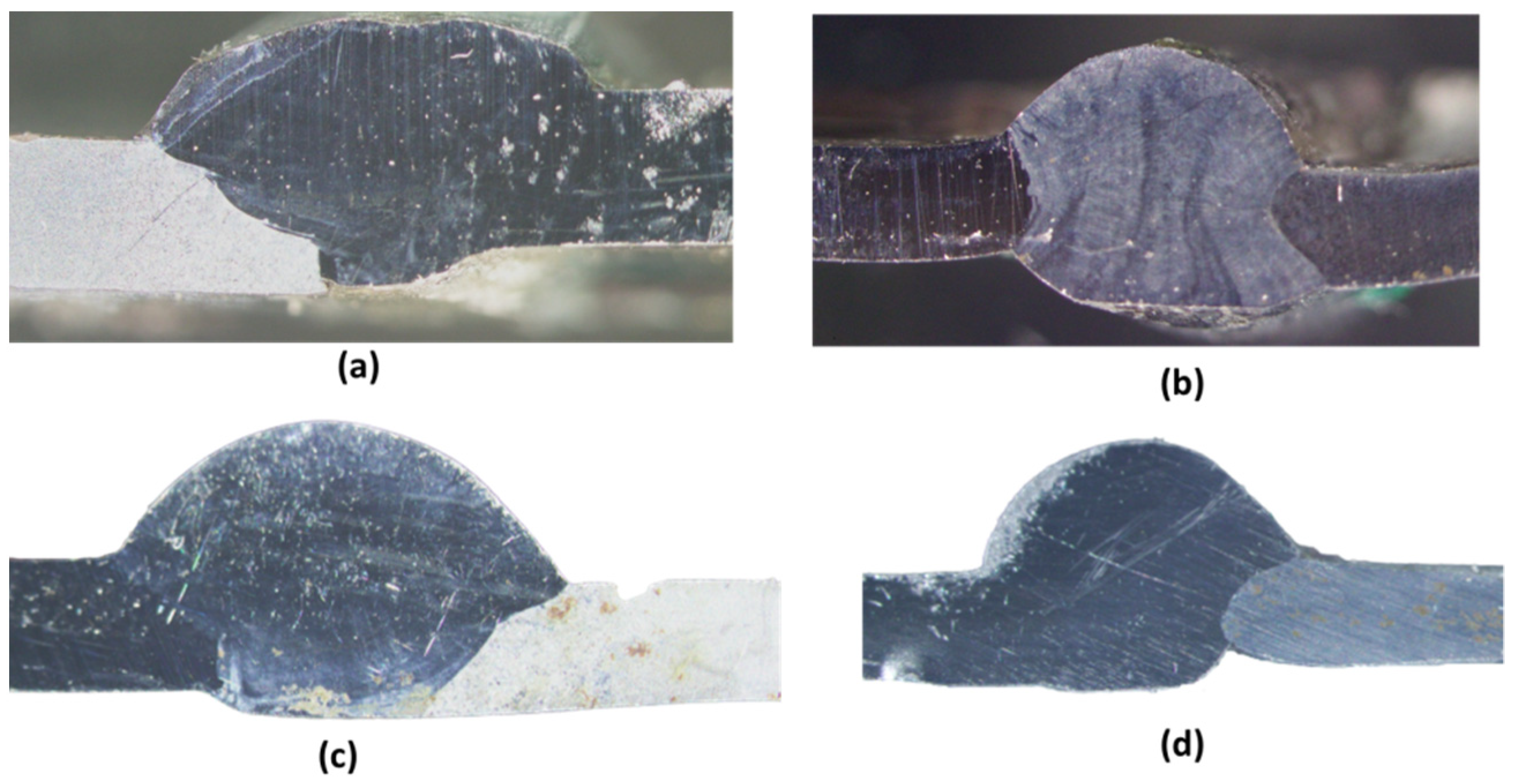
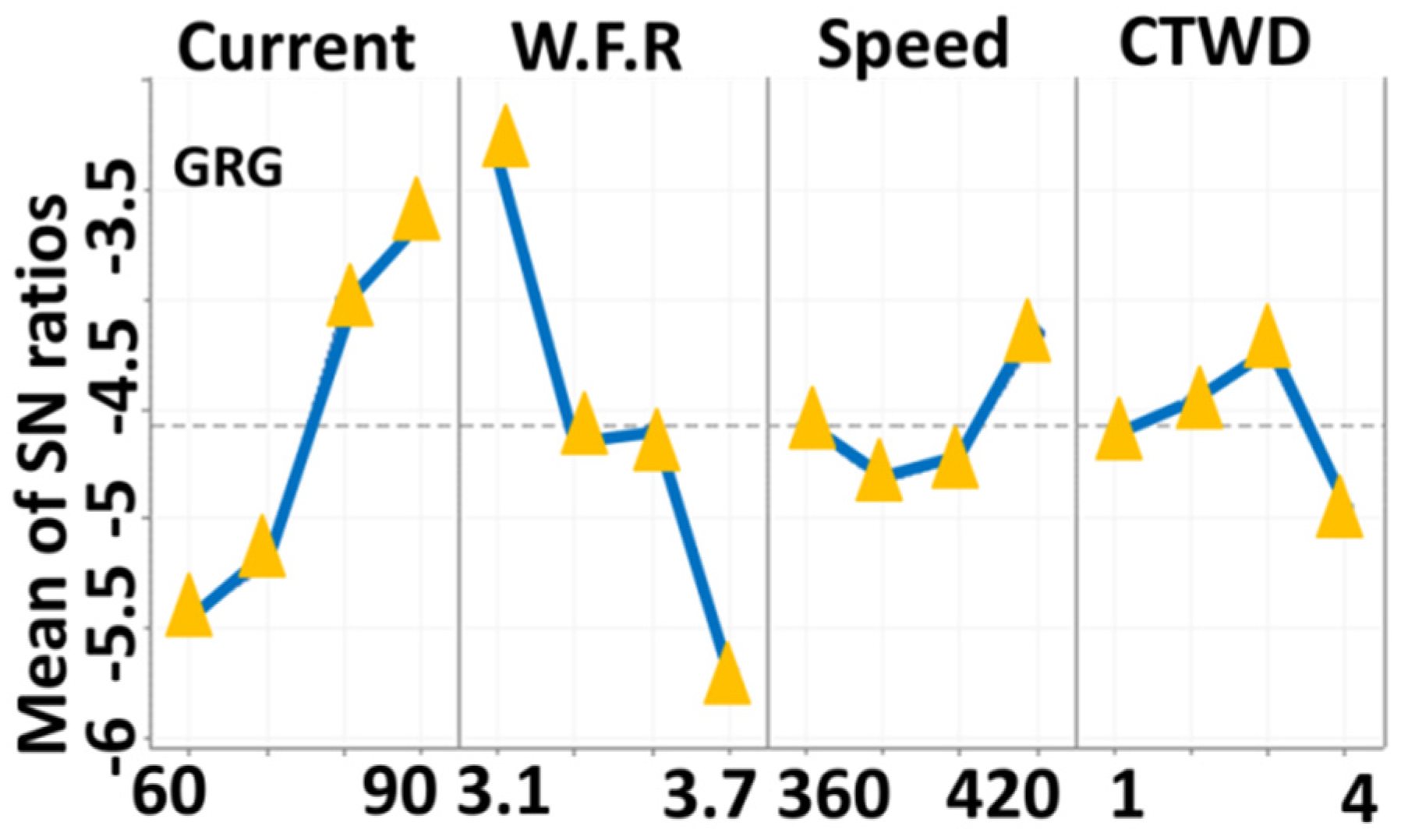

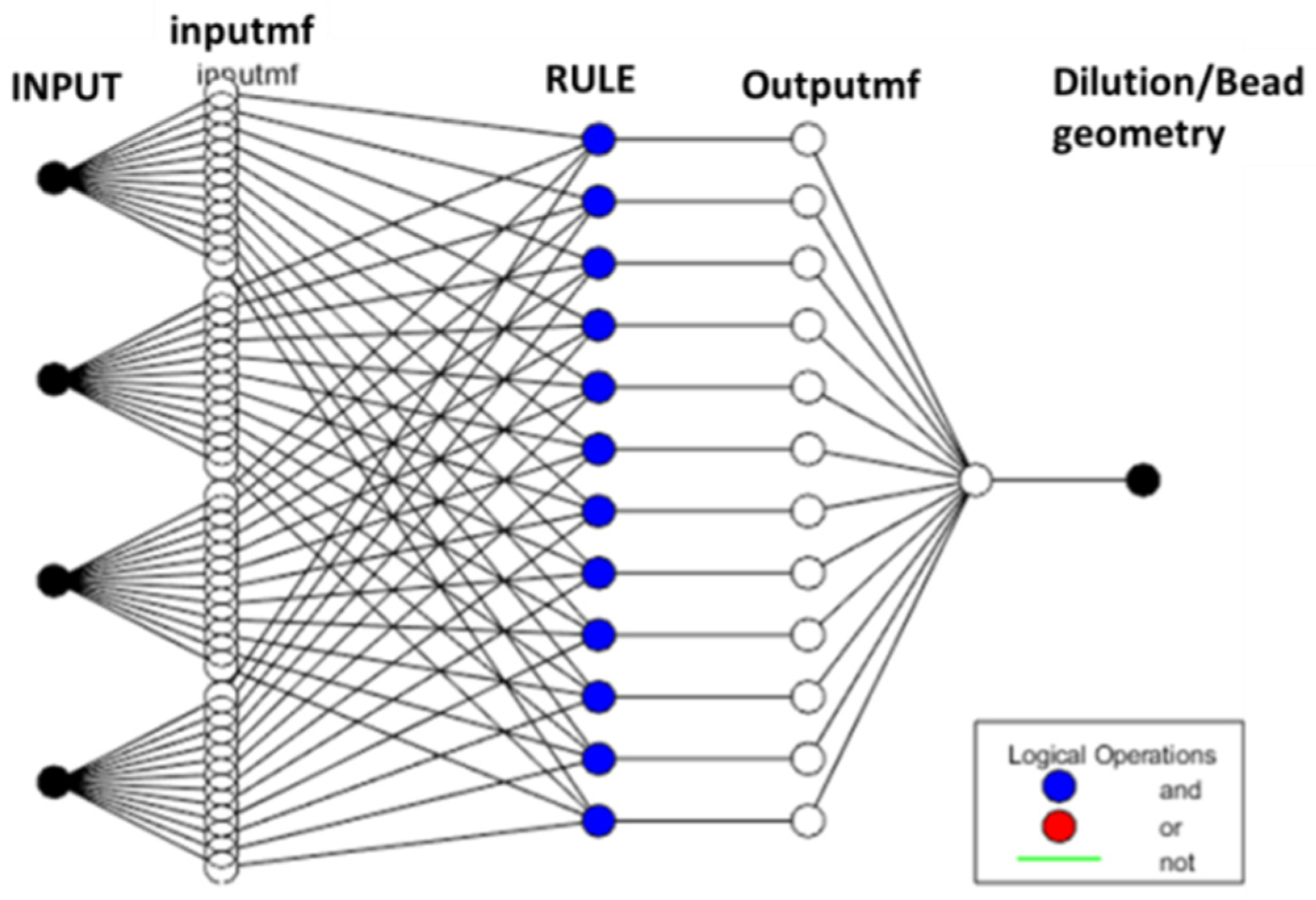
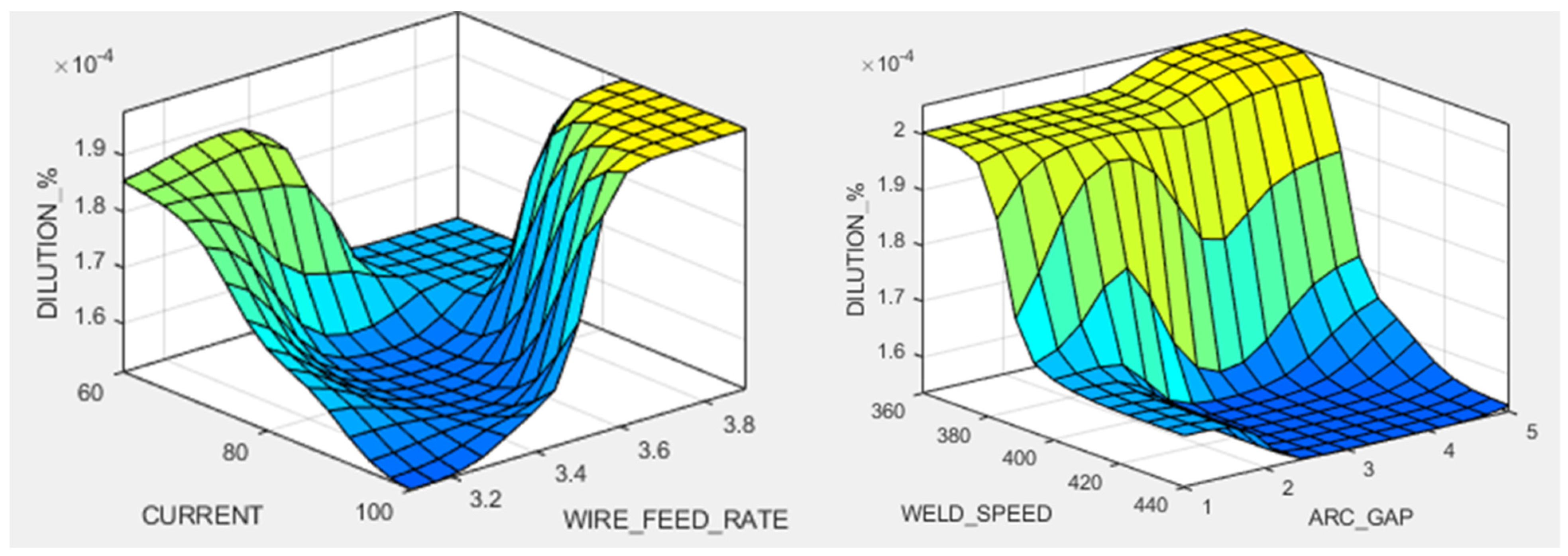
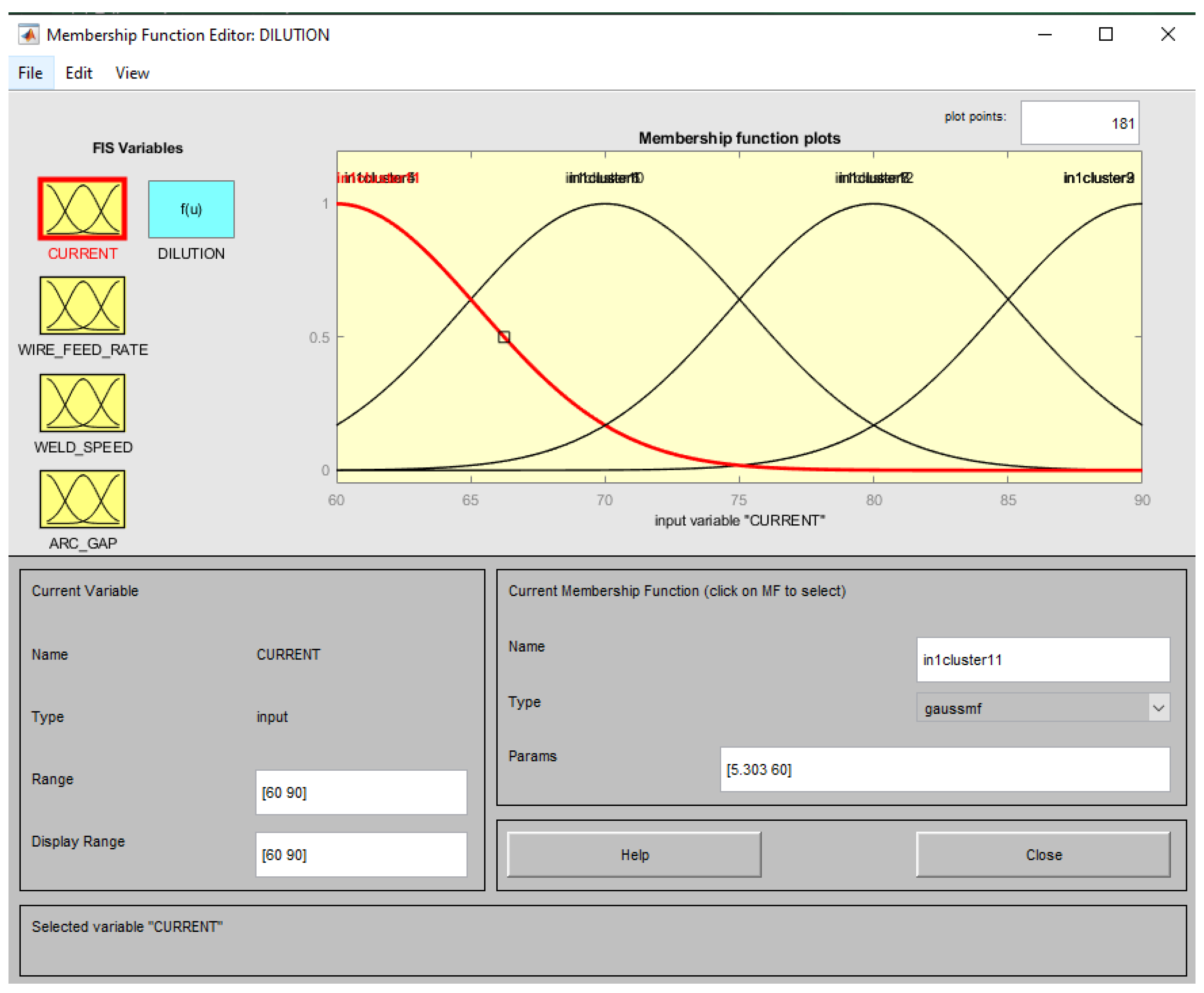

| Sample No. | Welding Current | Wire Feed Rate | Welding Speed | CTWD |
|---|---|---|---|---|
| A | m/min | mm/min | mm | |
| DM-1 | 60 | 3.1 | 360 | 1 |
| DM-2 | 60 | 3.3 | 380 | 2 |
| DM-3 | 60 | 3.5 | 400 | 3 |
| DM-4 | 60 | 3.7 | 420 | 4 |
| DM-5 | 70 | 3.1 | 380 | 3 |
| DM-6 | 70 | 3.3 | 360 | 4 |
| DM-7 | 70 | 3.5 | 420 | 1 |
| DM-8 * | 70 | 3.7 | 400 | 2 |
| DM-9 | 80 | 3.1 | 400 | 4 |
| DM-10 | 80 | 3.3 | 420 | 3 |
| DM-11 | 80 | 3.5 | 360 | 2 |
| DM-12 | 80 | 3.7 | 380 | 1 |
| DM-13 | 90 | 3.1 | 420 | 2 |
| DM-14 | 90 | 3.3 | 400 | 1 |
| DM-15 | 90 | 3.5 | 380 | 4 |
| DM-16 | 90 | 3.7 | 360 | 3 |
| Composition | Cr | Ni | C | Mn | S | P | Si | Mo | Ti | Cu | Al | N | Fe |
|---|---|---|---|---|---|---|---|---|---|---|---|---|---|
| AISI 304 | 19.7 | 8.09 | 0.02–0.08 | 0.8 | 0.03 | 0.04 | 0.35 | 0.208 | - | 0.44 | 0.003 | 0.1 | Bal. |
| AISI 1008 | 0.032 | 0.014 | 0.082 | 0.316 | 0.012 | 0.018 | 0.02 | 0.003 | - | 0.04 | 0.02 | - | Bal. |
| ER70S-6 | ≤0.15 | ≤0.15 | 0.06–0.14 | 1.4–1.6 | ≤0.025 | ≤0.025 | 0.8–1.0 | ≤0.15 | ≤0.15 | ≤0.5 | - | - | Bal. |
| Sample No. | Experimental Results | Grey Coefficient | GRG | Rank | ||||||
|---|---|---|---|---|---|---|---|---|---|---|
| D% | R | P | WB | D% | R | P | WB | |||
| DM-1 | 27.13 | 2.28 | 1.45 | 4.02 | 1.00 | 0.39 | 0.33 | 0.71 | 0.6095 | 9 |
| DM-2 | 27.95 | 2.15 | 1.48 | 4.00 | 0.59 | 0.52 | 0.38 | 0.76 | 0.5616 | 11 |
| DM-3 | 28.63 | 2.09 | 1.51 | 4.10 | 0.44 | 0.61 | 0.44 | 0.58 | 0.5179 | 12 |
| DM-4 | 28.93 | 2.12 | 1.53 | 4.31 | 0.40 | 0.56 | 0.49 | 0.39 | 0.4590 | 16 |
| DM-5 | 27.60 | 2.18 | 1.55 | 4.01 | 0.72 | 0.48 | 0.55 | 0.74 | 0.6207 | 5 |
| DM-6 | 27.61 | 2.31 | 1.54 | 4.32 | 0.71 | 0.37 | 0.52 | 0.38 | 0.4954 | 14 |
| DM-7 | 29.51 | 1.96 | 1.56 | 4.13 | 0.33 | 1.00 | 0.59 | 0.54 | 0.6158 | 8 |
| DM-8 * | 29.13 | 2.09 | 1.55 | 4.33 | 0.37 | 0.61 | 0.55 | 0.38 | 0.4780 | 15 |
| DM-9 | 27.57 | 2.13 | 1.58 | 3.92 | 0.73 | 0.55 | 0.68 | 1.00 | 0.7392 | 2 |
| DM-10 | 28.04 | 2.08 | 1.57 | 3.95 | 0.57 | 0.63 | 0.63 | 0.89 | 0.6800 | 3 |
| DM-11 | 27.24 | 2.33 | 1.60 | 4.30 | 0.92 | 0.36 | 0.81 | 0.40 | 0.6196 | 6 |
| DM-12 | 27.91 | 2.25 | 1.57 | 4.32 | 0.60 | 0.41 | 0.63 | 0.38 | 0.5081 | 13 |
| DM-13 | 27.84 | 2.08 | 1.60 | 3.92 | 0.63 | 0.63 | 0.81 | 1.00 | 0.7667 | 1 |
| DM-14 | 27.89 | 2.18 | 1.61 | 4.18 | 0.61 | 0.48 | 0.89 | 0.49 | 0.6194 | 7 |
| DM-15 | 27.24 | 2.35 | 1.60 | 4.35 | 0.92 | 0.34 | 0.81 | 0.37 | 0.6093 | 10 |
| DM-16 | 27.22 | 2.37 | 1.62 | 4.42 | 0.93 | 0.33 | 1.00 | 0.33 | 0.6491 | 4 |
| Response Table | |||||||
|---|---|---|---|---|---|---|---|
| Level | L1 | L2 | L3 | L4 | diff | Optimal | Rank |
| Welding current | 0.54 | 0.55 | 0.64 | 0.66 | 0.124 | I4 | 2 |
| Wire feed rate | 0.68 | 0.59 | 0.59 | 0.52 | 0.160 | F1 | 1 |
| Welding speed | 0.59 | 0.57 | 0.59 | 0.63 | 0.06 | S4 | 3 |
| CTWD | 0.59 | 0.61 | 0.62 | 0.58 | 0.041 | Z3 | 4 |
| Optimal condition | Level | ||||||
| Based on Response table | I4F1S4Z3 | Sample ID: C-1 | |||||
| Based on original L9 | I4F1S4Z2 | Sample ID: DM-13 | |||||
| Input Parameters | Notation |
|---|---|
| Welding current | x(1) |
| Feed rate | x(2) |
| Welding speed | x(3) |
| CTWD | x(4) |
| SI. No | Response | R-Sq (%) | Regression Equation |
|---|---|---|---|
| 1 | Dilution% | 87.44 | 17.08 − 0.02616 *x(1) + 1.290 *x(2) + 0.02232 *x(3) − 0.0998 *x(4) |
| 2 | Reinforcement | 91.2 | 3.439 + 0.003175 *x(1) + 0.0612 *x(2) − 0.004487 *x(3) + 0.01975 *x(4) |
| 3 | Penetration | 90.2 | 1.022 + 0.003750 *x(1) + 0.0425 *x(2) + 0.000250 *x(3) + 0.00500 *x(4) |
| 4 | Bead Width | 87.01 | 2.990 + 0.00255 *x(1) + 0.6200 *x(2) − 0.003000 *x(3) + 0.0170 *x(4) |
| SI. No | Response | R-Sq (%) | Regression Equation |
|---|---|---|---|
| 1 | Dilution % | 97.1 | 8.54 − 0.03363*x(1) + 1.290*x(2) + 0.04567*x(3) + 3.542*x(4) − 0.00934*x(3)*x(4) |
| 2 | Reinforcement | 98.53 | −71.4 + 0.2221*x(1) + 11.22*x(2) + 0.2637*x(3) − 3.28*x(4) − 0.001519*x(1)*x(1) − 0.000195*x(3)*x(3) + 0.0812*x(4)*x(4) − 0.0341*x(2)*x(3) + 0.850*x(2)*x(4) |
| 3 | Penetration | 99.98 | −1.451 + 0.06365*x(1) + 0.0645*x(2) + 0.001988*x(3) + 0.07569*x(4) − 0.000069*x(1)*x(1) + 0.000003*x(3)*x(3) − 0.003750*x(4)*x(4) − 0.004593*x(1)*x(2) − 0.000086*x(1)*x(3) − 0.000159*x(1)*x(4) + 0.000625*x(2)*x(3) − 0.000125*x(3)*x(4) |
| 4 | Bead Width | 99.99 | 150.98 − 0.33441*x(1) − 23.148*x(2) − 0.5267*x(3) + 4.994*x(4) + 0.002562*x(1)*x(1) − 0.125*x(2)*x(2) + 0.000344*x(3)*x(3) − 0.115*x(4)*x(4) − 0.012316*x(1)*x(2) + 0.000047*x(1)*x(3) − 0.000909*x(1)*x(4) + 0.07375*x(2)*x(3) − 1.275*x(2)*x(4) |
| Sample No. | I | F | S | Z | D% | R | P | WB |
|---|---|---|---|---|---|---|---|---|
| C-1 | 90 | 3.1 | 420 | 3 | 27.47 | 2.06 | 1.61 | 3.78 |
| E-1 | 100 | 3.1 | 420 | 2 | 27.71 | 2.13 | 1.61 | 4 |
| E-2 | 100 | 3.3 | 400 | 1 | 28.23 | 2.15 | 1.62 | 4.24 |
| E-3 | 100 | 3.5 | 380 | 4 | 27.19 | 2.41 | 1.67 | 4.58 |
| E-4 | 100 | 3.7 | 360 | 3 | 26.49 | 2.5 | 1.66 | 4.5 |
| E-5 | 90 | 3.9 | 360 | 3 | 26.49 | 2.45 | 1.67 | 4.38 |
| E-6 | 90 | 3.1 | 440 | 3 | 28.60 | 2.01 | 1.58 | 3.98 |
| E-7 | 90 | 3.1 | 420 | 5 | 28.68 | 2.06 | 1.55 | 4.09 |
| Sample No. | Regression Analysis | ANN | ANFIS | |||||||||
|---|---|---|---|---|---|---|---|---|---|---|---|---|
| D% | R | P | WB | D% | R | P | WB | D% | R | P | WB | |
| DM-1 | 27.14 | 2.28 | 1.43 | 4.05 | 27.24 | 2.16 | 1.49 | 4.31 | 27.13 | 2.28 | 1.45 | 4.02 |
| DM-2 | 28.12 | 2.15 | 1.46 | 4.04 | 27.94 | 2.14 | 1.49 | 4.00 | 27.95 | 2.15 | 1.48 | 4.00 |
| DM-3 | 28.72 | 2.08 | 1.48 | 4.14 | 28.86 | 2.07 | 1.50 | 4.11 | 28.50 | 2.14 | 1.5 | 4.15 |
| DM-4 | 28.95 | 2.10 | 1.50 | 4.35 | 28.93 | 2.12 | 1.49 | 4.31 | 28.93 | 2.12 | 1.53 | 4.31 |
| DM-5 | 27.52 | 2.16 | 1.52 | 4.05 | 27.59 | 2.17 | 1.54 | 4.01 | 27.60 | 2.18 | 1.55 | 4.01 |
| DM-6 | 27.60 | 2.28 | 1.52 | 4.35 | 27.61 | 2.30 | 1.55 | 4.30 | 27.61 | 2.31 | 1.54 | 4.32 |
| DM-7 | 29.50 | 1.98 | 1.53 | 4.17 | 28.28 | 2.24 | 1.55 | 3.93 | 29.51 | 1.96 | 1.56 | 4.13 |
| DM-8 * | 28.84 | 2.08 | 1.52 | 4.37 | 27.71 | 2.32 | 1.53 | 4.28 | 28.20 | 1.88 | 1.49 | 3.94 |
| DM-9 | 27.34 | 2.14 | 1.55 | 3.96 | 27.56 | 2.12 | 1.57 | 3.94 | 27.57 | 2.13 | 1.58 | 3.92 |
| DM-10 | 28.15 | 2.07 | 1.54 | 3.99 | 28.04 | 2.07 | 1.58 | 3.94 | 28.04 | 2.08 | 1.57 | 3.95 |
| DM-11 | 27.17 | 2.33 | 1.58 | 4.33 | 27.27 | 2.34 | 1.56 | 4.31 | 27.24 | 2.33 | 1.60 | 4.30 |
| DM-12 | 27.97 | 2.21 | 1.54 | 4.36 | 27.33 | 2.33 | 1.55 | 4.28 | 28.70 | 2.45 | 1.68 | 4.52 |
| DM-13 | 27.93 | 2.06 | 1.57 | 3.97 | 28.27 | 2.12 | 1.60 | 4.09 | 27.84 | 2.08 | 1.60 | 3.92 |
| DM-14 | 27.84 | 2.19 | 1.58 | 4.22 | 27.89 | 2.18 | 1.61 | 4.19 | 27.89 | 2.18 | 1.61 | 4.18 |
| DM-15 | 27.35 | 2.33 | 1.57 | 4.39 | 27.35 | 2.33 | 1.57 | 4.39 | 28.60 | 2.49 | 1.7 | 4.65 |
| DM-16 | 27.27 | 2.36 | 1.59 | 4.45 | 27.43 | 2.35 | 1.54 | 4.38 | 27.22 | 2.37 | 1.62 | 4.42 |
| Max. Error % | 1.01 | 1.78 | 2.06 | 1.15 | 4.89 | 14.2 | 5.1 | 7.31 | 4.9 | 10 | 7 | 9 |
| MRE | 0.32 | 0.66 | 1.77 | 0.91 | 0.96 | 2.55 | 1.34 | 1.37 | 0.72 | 1.71 | 1.11 | 1.36 |
| RMSE | 0.12 | 0.02 | 0.03 | 0.04 | 0.51 | 0.1 | 0.03 | 0.1 | 0.53 | 0.09 | 0.05 | 0.15 |
| Sample No. | Regression Analysis | ANN | ANFIS | |||||||||
|---|---|---|---|---|---|---|---|---|---|---|---|---|
| D% | R | P | WB | D% | R | P | WB | D% | R | P | WB | |
| C-1 | 27.55 | 1.82 | 1.56 | 4.35 | 28.47 | 2.09 | 1.58 | 3.98 | 27.9 | 2.08 | 1.6 | 3.93 |
| E-1 | 27.60 | 1.39 | 1.57 | 5.29 | 27.96 | 2.16 | 1.61 | 4.19 | 28.00 | 2.09 | 1.61 | 3.94 |
| E-2 | 27.51 | 1.52 | 1.59 | 5.52 | 27.84 | 2.18 | 1.61 | 4.25 | 28.00 | 2.19 | 1.62 | 4.2 |
| E-3 | 27.02 | 1.66 | 1.58 | 5.62 | 27.37 | 2.34 | 1.55 | 4.40 | 28.8 | 2.51 | 1.72 | 4.68 |
| E-4 | 26.93 | 1.70 | 1.61 | 5.66 | 27.54 | 2.35 | 1.55 | 4.42 | 27.4 | 2.39 | 1.63 | 4.45 |
| E-5 | 27.52 | 2.66 | 1.57 | 3.96 | 27.34 | 2.35 | 1.50 | 4.40 | 27.2 | 2.37 | 1.62 | 4.42 |
| E-6 | 27.90 | 1.63 | 1.52 | 4.39 | 29.03 | 2.00 | 1.55 | 3.96 | 29.2 | 2.18 | 1.67 | 4.1 |
| E-7 | 26.79 | 1.83 | 1.51 | 4.43 | 28.27 | 2.02 | 1.56 | 3.96 | 29 | 2.24 | 1.66 | 4.13 |
| Max. Error % | 6.59 | 34.53 | 6.05 | 32.16 | 4.89 | 14.26 | 9.98 | 7.31 | 5.91 | 10.05 | 7.01 | 9.01 |
| MRE | 2.31 | 22.17 | 3.47 | 19.27 | 2.08 | 2.47 | 3.68 | 2.49 | 1.26 | 2.49 | 1.59 | 1.50 |
| RMSE | 0.86 | 0.55 | 0.06 | 0.90 | 0.65 | 0.07 | 0.08 | 0.13 | 0.77 | 0.11 | 0.06 | 0.09 |
| Response | Initial Design Run | ANN Model | ANFIS Model | Exp. Result | Improvement from Initial Condition (%) |
|---|---|---|---|---|---|
| Optimal parameters | DM8-I2F4S3Z2 | C1-I4F1S4Z3 | C1-I4F1S4Z3 | C1-I4F1S4Z3 | |
| Dilution % | 29.13 | 28.47 | 27.9 | 27.47 | 5.7 |
| Reinforcement | 2.09 | 2.09 | 2.08 | 2.06 | 1.4 |
| Penetration | 1.55 | 1.58 | 1.6 | 1.61 | 3.9 |
| Bead Width | 4.33 | 3.98 | 3.93 | 3.78 | 12.7 |
| GRG | 0.48 | - | - | 0.769 | 60.2 |
Publisher’s Note: MDPI stays neutral with regard to jurisdictional claims in published maps and institutional affiliations. |
© 2021 by the authors. Licensee MDPI, Basel, Switzerland. This article is an open access article distributed under the terms and conditions of the Creative Commons Attribution (CC BY) license (https://creativecommons.org/licenses/by/4.0/).
Share and Cite
Devaraj, J.; Ziout, A.; Qudeiri, J.E.A. Grey-Based Taguchi Multiobjective Optimization and Artificial Intelligence-Based Prediction of Dissimilar Gas Metal Arc Welding Process Performance. Metals 2021, 11, 1858. https://doi.org/10.3390/met11111858
Devaraj J, Ziout A, Qudeiri JEA. Grey-Based Taguchi Multiobjective Optimization and Artificial Intelligence-Based Prediction of Dissimilar Gas Metal Arc Welding Process Performance. Metals. 2021; 11(11):1858. https://doi.org/10.3390/met11111858
Chicago/Turabian StyleDevaraj, Jeyaganesh, Aiman Ziout, and Jaber E. Abu Qudeiri. 2021. "Grey-Based Taguchi Multiobjective Optimization and Artificial Intelligence-Based Prediction of Dissimilar Gas Metal Arc Welding Process Performance" Metals 11, no. 11: 1858. https://doi.org/10.3390/met11111858
APA StyleDevaraj, J., Ziout, A., & Qudeiri, J. E. A. (2021). Grey-Based Taguchi Multiobjective Optimization and Artificial Intelligence-Based Prediction of Dissimilar Gas Metal Arc Welding Process Performance. Metals, 11(11), 1858. https://doi.org/10.3390/met11111858






